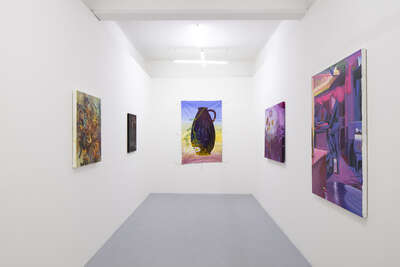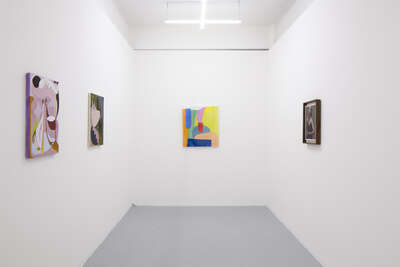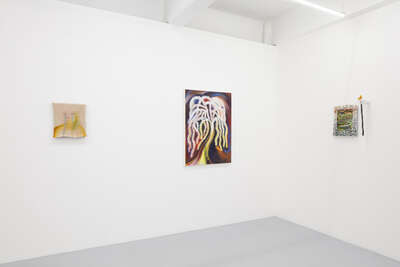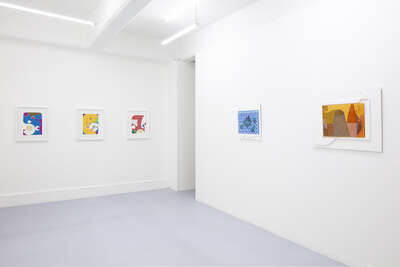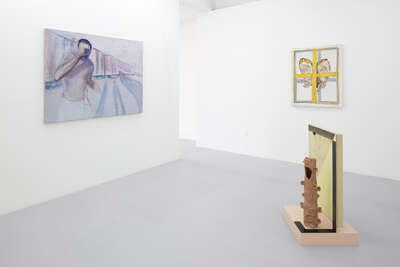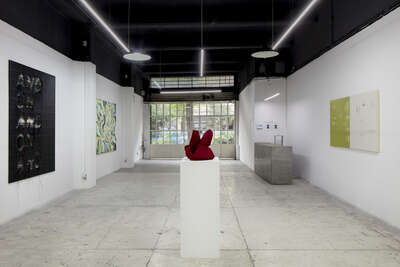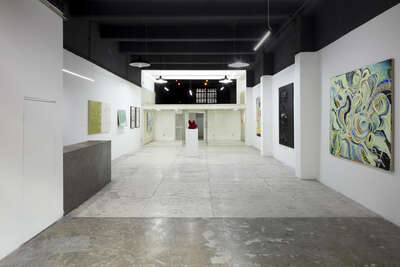TODO ESTE TIEMPO, TODA ESTA PINTURA: 11 AÑOS DE LA GALERIA KAREN HUBER
SEPTEMBER 4 - DECEMBER, 2025
AD MINOLITI, ALEJANDRA LAVIADA, ALEJANDRO GARCÍA CONTRERAS, ALIDA CERVANTES, ALLAN VILLAVICENCIO, ANA SEGOVIA, ANDREW BIRK, ANDREW HOLMQUIST, CAROLINA FUSILIER, CECILIA GRANARA, CÉSAR RANGEL, CHRISTIAN CAMACHO, DANIEL HOROWITZ, EDGAR COBIÁN, ENDY HUPPERICH, ERIC VALENCIA, EUGENIA MARTÍNEZ, EVA AYACHE - VANDERHORST, IAN GROSE, JERÓNIMO RUEDI, KANAKO NAMURA, KEKE VILABELDA, KRISTI KONGI, LUCÍA VIDALES, LUIS HAMPSHIRE, MALÙ DALLA PICCOLA, MANUEL FORTE, MANUELA SOLANO, MARC BRESLIN, MERIKE ESTNA, NICOLE CHAPUT, OTHIANA ROFFIEL, RAFAEL URIEGAS AND YANN LETO
Galería Karen Huber opened its doors eleven years ago as a space dedicated to the promotion and dissemination of painting. Its firstlocation was on the ground floor of the interior of the Vizcaya building, and its inaugural exhibition was a solo show by Ad Minoliti. Atthe time, in 2014, presenting a gallery entirely devoted to painting was a bold undertaking, as art institutions and the market in Mexicowere largely focused on other media considered more “contemporary.” Within this context, the practice of painting and reflection onthe pictorial were often perceived as somewhat anachronistic. Against this backdrop, the gallery committed to promoting research intopainting and its possibilities—a commitment it has maintained to this day.
After its first decade and a year dedicated to promoting and disseminating contemporary painting—produced primarily by local artists while maintaining engagement and dialogue with international collaborators—Galería Karen Huber presents the exhibition All This Time, All This Painting, a show that, in a way, recapitulates the history of this space. The exhibition features artists who have been presentsince the gallery’s inauguration and the beginning of its program, such as Ad Minoliti, Manuela Solano, and Rafael Uriegas, as well asartists who have accompanied it throughout much of its history, including Ana Segovia, Allan Villavicencio, Luis Hampshire, Lucía Vidales, and Othiana Roffiel. It also presents artists who have collaborated with the program at some point, such as Jerónimo Ruedi, Alejandra Laviada, or Nicole Chaput, and even artists participating for the first time, such as Carolina Fusilier. These mentions are not intended to be exhaustive. In total, 34 artists are included—presences considered essential in a show that seeks to establish relationships and dialogues between different approaches, while offering a broad overview of contemporary painting. The survey is not limited to local practices; it also includes artists who do not reside in Mexico but have collaborated with the gallery throughout much of its first eleven years, such as Merike Estna, Kanako Namura, and Keke Vilabelda, as well as first-time collaborations, like those of Malù dalla Piccola or Eva Ayache-Vanderhost.
All This Time, All This Painting continues the gallery’s interest in disseminating multiple approaches to understanding painting and exploring its possibilities—sometimes beyond the more traditional ways of conceiving the medium. There are works, such as those by Luis Hampshire, Alejandra Laviada, and Alejandro García Contreras, that explore painting’s relationship with other formats, disciplines, or media, including the three-dimensional, sculptural, and ceramic. Other works investigate formal aspects, such as the relationship between painting and its support and presentation, the use of unconventional materials, and the development of unique techniques, as seen in artists like Christian Camacho, Andrew Birk, and César Rangel. Similarly, the gallery has continued programming that addresses multiple thematic perspectives and inquiries. From its beginnings, and even before certain institutional and market trends gained prominence,the gallery has highlighted feminist- and queer-inspired proposals. During the months in which this exhibition is on view, a public program has been prepared to contribute to the discussion and reflection on these themes and on painting itself.
For the presentation of All This Time, All This Painting, Galería Karen Huber expands into a space on the ground floor at 120 Bucareli, underthe initiative called ISLA—a venue for the temporary presentation of spaces, initiatives, or events.
Daniel Garza Usabiaga
La Galería Karen Huber abrió sus puertas hace once años como un espacio dedicado a la promoción y divulgación de la pintura. Su primer establecimiento se ubicó en la planta baja del interior del edificio Vizcaya y su exposición inaugural fue un show individual de Ad Minoliti. Cuando esto sucedió, en el 2014, presentar una galería dedicada enteramente a la pintura resultaba algo aventurado ya que las instituciones y el mercado del arte en México se encontraban interesados, en gran medida, en otros medios considerados como más “contemporáneos”. Dentro de este sistema, la práctica de la pintura y la reflexión sobre lo pictórico eran percibidas como un tanto anacrónicas. En contracorriente a este escenario, la galería apostó por la promoción de investigaciones sobre la pintura y sus posibilidades; un compromiso que ha mantenido hasta el presente.
Después de su primera década y un año de trabajar para promocionar y divulgar pintura contemporánea, producida principalmente por artistas locales y sin dejar de lado la participación y diálogo con colaboradores internacionales, la Galería Karen Huber presenta la exposición Todo este tiempo, toda esta pintura – una muestra que de cierta manera recapitula la historia de este espacio. Primeramente, participan artistas que estuvieron presentes desde la inauguración de la galería y el inicio de su programa, como Ad Minoliti, Manuela Solano y Rafael Uriegas, así como artistas que la han acompañado durante la mayor parte de su historia, como Ana Segovia, Allan Villavicencio, Luis Hampshire, Lucía Vidales y Othiana Roffiel. Del mismo modo, en esta muestra se presentan artistas que alguna vez han colaborado en el programa, como Jerónimo Ruedi, Alejandra Laviada o Nicole Chaput e, inclusive, artistas que lo hacen por primera vez, como Carolinia Fusilier. Las menciones, en este caso, no pretenden ser exhaustivas. En total participan 34 artistas; todas presencias que se consideran imprescindibles en una muestra que busca plantear relaciones y diálogos entre distintas propuestas, así como ofrecer un panorama amplio de la pintura contemporánea. La revisión no se limita a lo local; la muestra contempla la presencia de artistas que no residen en México y que han colaborado con la galería durante gran parte de sus primeros once años, como Merike Estna, Kanako Namura y Keke Vilabelda, hasta primeras colaboraciones, como sucede con Malù dalla Piccola o Eva Ayache-Vanderhost.
La exposición Todo este tiempo, toda esta pintura da continuidad al interés de la galería en difundir múltiples propuestas de cómo se puede entender la pintura así como explorar sus posibilidades y aspectos que pueden ir más allá de la manera más tradicional en la que se entiende el medio. De esta forma, hay piezas –como las de Luis Hampshire, Alejandra Laviada y Alejandro García Contreras - que exploran la relación de la pintura con otros formatos, disciplinas o medios como lo tridimensional, lo escultórico y la cerámica. También hay obras con indagaciones formales como la relación de la pintura con su soporte y montaje, el uso de materiales no convencionales y el desarrollo de técnicas propias, cuestiones que están presentes en artistas como Christian Camacho, Andrew Birk y César Rangel. Del mismo modo, la galería ha continuado con una programación con propuestas que abordan múltiples perspectivas temáticas o investigaciones. Desde sus inicios, y antes de la preponderancia de ciertas tendencias institucionales y mercantiles, en el programa de la galería han destacado las propuestas de inspiración feminista o queer. La galería ha preparado un programa público durante los meses que estará abierta esta muestra con el fin de sumar a la discusión y reflexionar sobre estos temas y cuestiones sobre la pintura.
Para la presentación de Todo este tiempo, toda esta pintura la Galería Karen Huber se extiende a un local en la planta baja del número 120 de Bucareli en lo que será una iniciativa con el nombre de ISLA– un espacio para la presentación temporal de establecimientos, iniciativas o eventos.
Daniel Garza Usabiaga

